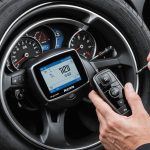Vital Strategies to Enhance Hydraulic Brake Efficiency in Vehicles Navigating Hilly Terrain
When it comes to driving in hilly terrain, the efficiency and reliability of your vehicle’s braking system are paramount. Hydraulic brakes, in particular, offer superior performance and control, but they require specific strategies to ensure they operate at their best. Here’s a comprehensive guide on how to enhance the efficiency of hydraulic brakes in vehicles navigating challenging terrains.
Understanding Hydraulic Brakes
Before diving into the strategies, it’s essential to understand how hydraulic brakes work and their advantages.
Additional reading : Ultimate checklist for ensuring your off-road vehicle”s rear differential lock works effectively
How Hydraulic Brakes Work
Hydraulic brakes use a sealed system filled with brake fluid. When you press the brake pedal, the fluid transfers pressure to the brake calipers, which then move the brake pads against the rotors to slow down or stop the vehicle. This system provides unmatched braking power and precision, making it ideal for high-speed or technical driving[1].
Advantages of Hydraulic Brakes
- Unmatched Braking Power: Hydraulic brakes offer stronger and more consistent braking force, which is crucial for navigating steep hills and technical terrain.
- Precision and Control: With superior modulation, hydraulic systems allow for fine-tuning of braking pressure, perfect for quick stops or maintaining control on descents.
- Low Maintenance (Short-Term): The sealed hydraulic system keeps dirt and debris out, reducing wear and tear compared to mechanical cables[1].
Preparing Your Braking System for Hilly Terrain
To ensure your hydraulic brakes perform optimally in hilly terrain, several preparatory steps are necessary.
Have you seen this : Crucial safety guidelines for seamlessly installing a gps tracking system in your vehicle
1. Inspect and Maintain Brake Components
Regular inspection of brake components is critical. Here are some key areas to focus on:
-
Brake Pads: Check for wear and replace them if necessary. Worn-out brake pads can significantly reduce stopping power and increase the risk of brake fade.
“`plaintext -
Inspect the thickness of the brake pads.
-
Look for signs of wear, such as scoring or excessive heat damage.
-
Replace the pads with high-quality, heavy-duty options designed for demanding conditions.
“` -
Rotors: Ensure the rotors are in good condition. Warped or excessively worn rotors can lead to poor braking performance.
“`plaintext -
Check for any signs of warping or excessive wear.
-
Use high-quality rotors that enhance heat dissipation, such as drilled and slotted rotors[4].
“` -
Brake Fluid: Brake fluid is crucial for the hydraulic system. Over time, it can absorb moisture, reducing its boiling point and braking efficiency.
“`plaintext -
Flush and replace the brake fluid regularly, especially before heading into challenging terrain.
-
Use high-quality brake fluid that is resistant to moisture absorption and maintains its viscosity under high temperatures[4].
“`
2. Optimize Weight Distribution
Proper weight distribution can significantly impact braking performance, especially in hilly terrain.
- Balance the Load: Ensure the vehicle is loaded evenly to avoid uneven weight distribution, which can affect braking performance.
“`plaintext - Distribute heavy items evenly across the vehicle.
- Avoid overloading, as this can put excessive stress on the braking system.
“`
3. Use Appropriate Driving Techniques
Driving techniques play a crucial role in maintaining control and safety while navigating hilly terrain.
-
Engine Braking: Use engine braking to reduce reliance on the brakes, especially when descending steep hills.
“`plaintext -
Downshift to a lower gear to use the engine’s compression to slow down the vehicle.
-
This technique helps in reducing brake wear and preventing overheating[4].
“` -
Gradual Braking: Apply brakes gradually and progressively to avoid sudden stops that can cause skidding.
“`plaintext -
Use gentle and controlled braking to maintain traction.
-
Avoid abrupt braking, especially on slippery or uneven surfaces[4].
“`
Enhancing Braking Performance in Challenging Conditions
In addition to regular maintenance and proper driving techniques, there are several strategies to enhance braking performance in challenging conditions.
1. Winter and Wet Conditions
Driving in winter or wet conditions requires special attention to braking.
-
Upgrade to Winter-Ready Brake Pads: Use brake pads designed for cold and harsh conditions.
“`plaintext -
Consider pads like R1 PERFORMANCE Off-Road/Tow Series Brake Pads or R1 SUPER Heavy Duty Series Brake Pads[4].
“` -
Check Tire Pressure: Ensure your tires have sufficient tread depth and are properly inflated.
“`plaintext -
Use winter or all-weather tires for better traction.
-
Maintain the recommended tire pressure to improve braking efficiency[4].
“`
2. Off-Road and Steep Descents
For vehicles frequently navigating off-road or steep descents, additional measures can enhance safety and control.
-
Hill Descent Control Systems: Utilize advanced driver-assist technologies like Ford’s Hill Descent Control™.
“`plaintext -
This system automatically adjusts braking power to individual wheels to maintain a pre-set speed, ensuring better control and stability on steep or uneven slopes[2].
“` -
Regular Brake Service: Schedule regular brake service to ensure all components are in top condition.
“`plaintext -
Have your brakes inspected by a professional to identify and address any potential issues before they become critical[4].
“`
Comparative Analysis: Mechanical vs. Hydraulic Brakes
To fully appreciate the benefits of hydraulic brakes, it’s helpful to compare them with mechanical brakes.
| Feature | Mechanical Disc Brakes | Hydraulic Disc Brakes |
|---|---|---|
| Mechanism | Steel cable system | Sealed hydraulic fluid system |
| Braking Power | Good but less precise | Superior stopping power and precision |
| Cost | Affordable upfront and cheaper to maintain | Higher initial and long-term costs |
| Maintenance | DIY-friendly, simple cable adjustments | Requires professional tools and expertise |
| Performance in Wet Conditions | Less efficient | Reliable in all weather conditions |
| Rim Wear | Not applicable | No rim wear |
Practical Insights and Actionable Advice
Here are some practical tips and advice to keep in mind when enhancing the efficiency of your hydraulic brakes:
Tips for Safe Braking
-
Stay Calm During Skids: If you begin to skid, avoid slamming on the brakes. Instead, steer gently in the direction of the skid to regain control, then brake carefully once you have traction[4].
-
Use the Right Brake Pads: Always use high-quality brake pads designed for your specific driving conditions. For example, if you frequently drive in wet or muddy conditions, use pads that are optimized for such environments[4].
Maintenance Schedule
-
Regular Inspections: Schedule regular inspections of your brake components to ensure they are in good condition.
“`plaintext -
Check brake pads, rotors, and brake fluid regularly.
-
Address any issues promptly to avoid more severe problems later on.
“` -
Professional Servicing: While some maintenance can be DIY, hydraulic brakes often require professional servicing, especially when it comes to bleeding the brake fluid or replacing components[1].
Enhancing the efficiency of hydraulic brakes in vehicles navigating hilly terrain involves a combination of regular maintenance, proper driving techniques, and the use of advanced technologies. By understanding how hydraulic brakes work, preparing your braking system, and using the right strategies for challenging conditions, you can ensure your vehicle’s safety and performance.
As a driver, it’s crucial to stay informed and proactive about your vehicle’s braking system. Here’s a final quote from a braking expert:
“Hydraulic brakes are a game-changer for drivers who frequently navigate challenging terrains. However, their performance is only as good as the maintenance and care they receive. Regular inspections, proper driving techniques, and the use of high-quality components can make all the difference in ensuring your safety on the road.”
By following these strategies and tips, you can maximize the efficiency of your hydraulic brakes and enjoy a safer, more controlled driving experience, no matter the terrain.









